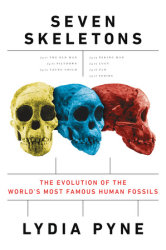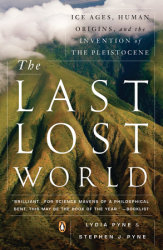News broke a little over a week ago that a key discovery had been made regarding the origin of one of the scientific community’s most embarrassing hoaxes: the rough assemblage of human and orangutan skull bones known as Piltdown Man. According to a study published in Royal Society Open Science all of the components used to create the faux fossil likely came from one source, and the only person who would have had the skill to put them together was Piltdown Man’s supposed discoverer: amateur archaeologist Charles Dawson.
Once touted as evidence of the proverbial missing link, the composite skull was reported to have been found by Dawson in 1912 near the English town of Piltdown. Frustrated by their own fruitless search for evidence of ancient man in Britain, the English scientific establishment was quick — too quick — to verify Dawson’s find as authentic. The Piltdown Man entered history books and stayed there until it was conclusively proven to be a hoax in 1953.
The hoax was responsible for a lot of damage. Its existence muddled our understanding of humanity’s evolution, leading scientists to doubt the authenticity of legitimate fossils like the Taung Child, and its exposure as a fraud eroded public trust in the theory of evolution.
In the seventy-odd years since Piltdown Man was proven to be a fraud, scientists and historians have eagerly debated the identity of its creator. Dawson, who died in 1916, has remained a prime suspect, but was he really the hoaxer or just another one of the hoaxed? Does this new report conclusively prove that he was the perpetrator, or is it just another educated guess?
We discussed Piltdown Man and other well-known bones with Lydia Pyne, author of Seven Skeletons: The Evolution of the World’s Most Famous Fossils. In this fascinating read, Pyne shares the stories behind the stories of not only Piltdown Man, but Taung Child, the Australopithecus afarensis skeleton known to the world as “Lucy”, and others.
PENGUIN RANDOM HOUSE: How did you come up with the concept for Seven Skeletons?
LYDIA PYNE: A couple of years ago I was interested in the idea of writing the biography of an object. As a trained historian, I’m interested in, of course, biography, and I got to thinking about what it would be like to write the scientific biography of an object. I came to this because of my dual background in the history of science and anthropology. I became really curious about the stories these fossils had to tell. I think, generally, the concept is that these fossils are discovered and then are part of a scientific controversy, and then are put in a museum, but I wanted to know what happened between those big stages: What are the stories in the media and the press? What are people saying about them internally in the scientific communities? I wanted to round out the biographies of these fossils, as well as explore what makes a fossil famous. I think those were the two things that got the ball rolling as a book project.
PRH: These are “celebrity skeletons” then, more or less. You wrote about seven of them. How did you choose those seven? I know you wrote that there were others people wanted you to cover.
LP: As soon as I would talk to colleagues in anthropology or history of science, the first thing they would ask is how I couldn’t write about this or that other thing: How could I limit myself to seven? I had to laugh, because if I had done everything that everyone thought was significant then I would have written an encyclopedia. When I picked the seven, I was interested in looking at the idea of scientific celebrity. I felt that each of these seven had a different kind. It wasn’t just that they were famous: They were famous in different ways. Piltdown is famous because it is a fake, and it is the longest perpetrated hoax in the history of science. The Taung Child feels like it is sort of a folk hero, especially when the little guy wins against scientific doubt and is vindicated in the end. I liked the idea of “Lucy” becoming an icon way outside of evolution studies. I was interested in finding these fossils that exemplified these kinds of scientific celebrity.
PRH: I was fascinated by the mystery of the Peking Man: that’s quite a story.
LP: The Peking Man fossils, in a nutshell, are famous because they are missing. I found the idea that there’s a famous set of fossils but we don’t know what they look like utterly intriguing. We only know them based on their casts and photographs, copies of them. The excavations were a huge institutional undertaking, an international effort. A great laboratory was built that was partially underwritten by the Rockefeller Foundation. There’s this huge machinery of science that had to happen to discover the Peking Man fossils.
Researchers were interested in finding evidence of early man in China and in Asia, but for so long in the beginning of the 20th century these efforts had focused on Africa and Southeast Asia. People began looking at China and where they could possibly find early human beings. By the 1930s, the scientific machinery is rolling around and people are finding a lot of fossils — railroad carts of them — to the Cenozoic Research Laboratory in Peking. As World War II started to pick up and it appeared that Japan was getting ready to invade Peking, scientists were concerned what might happen to the fossils. The head of the lab wrapped them up, packed them into crates, and sent them to the United States for safe keeping. They left there under military escort and were never seen again.
Part of what becomes so intriguing about this is the idea that they must be somewhere. Every paleoanthropologist or historian I’ve talked to has a pet theory about what happened and whether or not they’re going to turn up. For me, this feeling of it almost being a film noir kind of object — that there’s this hunt for it — builds on what the Peking Man is and why it has become famous.
PRH: You paralleled the search for Peking Man with “The Maltese Falcon.”
LP: Yes, that’s right.
PRH: There were some interesting characters involved in the Peking Man story, like Christopher Janus.
LP: Yes, you couldn’t make some of this stuff up! Janus was a larger-than-life character who was determined to find Peking Man and make this grand film, and then all of this screeched to a halt under nine counts of federal fraud.
PRH: In his mind, he had already cast Harrison Ford to play him in the movie.
LP: Why aim low?
PRH: Well, it was the perfect plot for an “Indiana Jones” film, anyway.
LP: Right, and I think that’s how he saw it.
PRH: One of the ways in which we see these fossils is in the sense of what they say about us as a species, and also individual nations.
LP: I’m really excited that you’re interested in this. I think there is a sort of nationalism that goes with the discovery of a fossil. It becomes a national symbol: a legitimization of how long we have been here and been this country. You certainly see that for Lucy, as sort of an icon for Ethiopia, and you definitely see it with China trying to find the Peking Man. Certainly, the Hobbit, Homo floresiensis, has become a symbol for Indonesia and a sense of national pride. You could see the flip side of that during the beginning of the 20th century when Britain was so determined that there would be evidence of early man in Britain somewhere and they just had to find it. I think that’s part of why the Piltdown Man resonated so well in the British scientific community: It was exactly what they thought, or hoped, they were going to find. The question of nationalism works both ways there.
PRH: Nationalism was one of the factors that led to the Piltdown Man being vetted so quickly, and it bogged down scientific progress for quite some time.
LP: Absolutely.
PRH: Do you have a theory about who might have been behind the Piltdown Man hoax?
LP: Much like Peking Man, every single person I talk to — scientist, archivist, historian, researcher — everyone had a theory about Piltdown. It’s really kind of fun to listen to people talk through the evidence: It’s almost like a “true crime” kind of vibe. Me? I love the mystery. I love not knowing. For me, that becomes really compelling from a literary perspective: that it’s okay for it to be unresolved. I don’t actually have a working hypothesis of who perpetrated the Piltdown hoax. Sorry to be a disappointment!
PRH: There are a lot of people committed to solving this thing, like the Piltdowners. Who are they?
LP: They were a group of scientists who came together in 2012, the centennial of the Piltdown discovery, and were reworking the evidence and testing them with a battery of new techniques: new DNA testing, stable isotope analysis, and a whole battery of techniques that weren’t available ten years ago, and certainly not fifty or sixty years ago when Piltdown was being debunked. There’s a sense of fun that modern day Piltdowners have of using modern day technology to find clues: We’ve gone through the archives, we’ve found the receipt for the kind of paint that was used for x, y, and z, but could we use these methodologies to uncover a bit more? I think there is a commitment to finding a resolution to the story, but it also becomes a way of trying out new methods within the science itself.
PRH: Can you talk a little bit about how our study of our origins has conflicted with some of the ideas about where we come from as a species? Is racism involved there? I know that some people were threatened by the African origins of Taung Child.
LP: I think that during the 20th century when Taung was first starting to make its appearance, what was really threatening was that the fossil discovery from Java, Pithecanthropus erectus, Eugène Dubois’s discovery, had centered the scientific community’s interest and focus in Southeast Asia. They felt that the question of humanity’s origin had been resolved: that Darwin’s theory (that humans originated in Africa) was nice, but that they had the evidence from Southeast Asia and that was more compelling to them. Raymond Dart, the discoverer of the Taung Child, was fighting against their commitment to thinking about Southeast Asia. Certainly, in Dart’s autobiography, he writes that he was going to be the instrument in Darwin’s hand to move the origins discussion back to Africa, but he was fighting an uphill battle to do that.
PRH: Dart was prone to florid prose, wasn’t he?
LP: Yes, and I think that the scientific community was reacting to that. It wasn’t just that he had a different theory they didn’t like: It was that he was flying by the seat of his pants. He wasn’t playing by the rules of the scientific establishment, or going through the process of peer review. He wasn’t interested in having other people really pick apart what he was saying. He was just interested in having it accepted, and that runs counter to the step-by-step process happening in the scientific communities of Europe.
PRH: What’s on the horizon for celebrity skeletons? The book ends with Australopithecus sediba.
LP: Yes, Sediba was discovered in 2008. It’s amazing how fast it became a media darling. It’s really kind of funny: When you go to the Evolutionary Studies Institute at the University of the Witwatersrand in Johannesburg and walk down the halls, there’s these giant posters of Sediba on the cover of Science magazine. It feels very much like you’re walking into a modeling agency and the head shots are on the walls! It’s a great thing to celebrate. These are the kinds of cool, scientific things that we’re discovering. Here are the questions that we’re asking and here’s what we’re doing with those.
Homo naledi was discovered in South Africa by the same group of researchers who discovered Australopithecus sediba. Naledi has really turned paleoanthropology on its ear in terms of how the field wants to do science. One of the things that struck me over the course of working on the book was that the idea of celebrity fossils is far from over. If I were to come back and write about seven more skeletons in ten or fifteen years, I think that there would be more possibilities to choose from.














